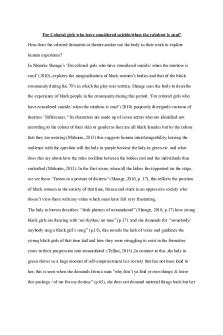Module 2 Essay - Practice Blackboard post discussing the Ohio Constitution PDF

| Title | Module 2 Essay - Practice Blackboard post discussing the Ohio Constitution |
|---|---|
| Course | Survey of Ohio History |
| Institution | Ohio University |
| Pages | 2 |
| File Size | 61.8 KB |
| File Type | |
| Total Downloads | 45 |
| Total Views | 139 |
Summary
Practice Blackboard post discussing the Ohio Constitution...
Description
Kari Alexander Dr. Morten Bach History 3170: Survey of Ohio History September 15, 2019 An Analysis of Ohio’s Constitution (1802) When the Ohio Constitution was created in November of 1802, members of the Ohio Constitutional Convention had to bear in mind the beliefs and values of the people. However, notable figures, such as governor Arthur St. Clair and the Federalist party, didn’t have the people of Ohio’s best interests in mind. Rather, they believed that people in general were inherently evil and incapable of governing themselves. Much to everyone’s benefit, St. Clair was forcibly removed from his position by President Thomas Jefferson. Even before that, the Federalists and St. Clair gained little traction in their efforts to control the convention. As a result, the majority created a constitution that gave power to the people of Ohio. To begin with, Article I of the Ohio Constitution served as the state’s Bill of Rights. Almost all of the rights listed in the United States Constitution can also be found in Ohio’s. These rights were mainly included as part of the 10th Amendment in the U.S. Constitution, which states that while the federal government is strictly held by the standards of the U.S. Constitution, the states can grant their citizens rights and freedoms that are not included in that document. The other most important takeaway from the Ohio Constitution is Article II which limited the power of the state’s governor. The requirements for a candidate’s electability (ex. age, citizenship in the state and country) were stricter as well as his proposed term limits (6 years). As is always the case, these higher standards ensured that no one particular person held too much power for too long. The Constitution of Ohio was made for the people because it was by the people. To get Ohioans involved, voter participation had to be increased. Luckily, with the passing of the Enabling Act of 1802, the people of that area had the opportunity to elect “one delegate for every twelve hundred inhabitants…a total of thirty-five delegates (Terzian, p. 359).” This required election of representatives proved to be an excellent incentive for citizens wanting Ohio to officially be granted statehood. Even more, that same legislation made suffrage more accessible for men who paid taxes, lived in the area for a year or more, and were of the legal age to vote. Potential voters were all over the area, and in order to get them actively involved in the political arena, the word had to be spread about the issues of the day. Media outlets like the Western Spy, Scioto Gazette, and many others wrote about debates on issues such as slavery and women’s suffrage. Such outlets realized the importance of an informed voter, and they wanted to deliver as much information as possible. The Ohio Constitution was written by and for those individuals who called Ohio their home. Ohioans actively participated in the political arena by actively campaigning about the issues they felt were important and worth addressing in such a historic document. With a limited
government and minimal requirements for voters, it was easier to make voices heard and to make them count. It is the result of these actions and grassroot efforts that account for Ohio finally becoming a state in 1803....
Similar Free PDFs

NTSI ch9 - blackboard post
- 2 Pages

Practice Problems Module 2
- 48 Pages

Uk constitution essay
- 3 Pages

Flexible Constitution Essay Plan
- 4 Pages

Constitution Essay Outline
- 2 Pages

Discussion Post Module 3
- 2 Pages

Module 9 - Discussion Post
- 2 Pages

The Texas Constitution
- 1 Pages

Framing the Constitution Notes
- 5 Pages

Ratifying the Constitution
- 2 Pages

The Constitution Worksheet
- 5 Pages
Popular Institutions
- Tinajero National High School - Annex
- Politeknik Caltex Riau
- Yokohama City University
- SGT University
- University of Al-Qadisiyah
- Divine Word College of Vigan
- Techniek College Rotterdam
- Universidade de Santiago
- Universiti Teknologi MARA Cawangan Johor Kampus Pasir Gudang
- Poltekkes Kemenkes Yogyakarta
- Baguio City National High School
- Colegio san marcos
- preparatoria uno
- Centro de Bachillerato Tecnológico Industrial y de Servicios No. 107
- Dalian Maritime University
- Quang Trung Secondary School
- Colegio Tecnológico en Informática
- Corporación Regional de Educación Superior
- Grupo CEDVA
- Dar Al Uloom University
- Centro de Estudios Preuniversitarios de la Universidad Nacional de Ingeniería
- 上智大学
- Aakash International School, Nuna Majara
- San Felipe Neri Catholic School
- Kang Chiao International School - New Taipei City
- Misamis Occidental National High School
- Institución Educativa Escuela Normal Juan Ladrilleros
- Kolehiyo ng Pantukan
- Batanes State College
- Instituto Continental
- Sekolah Menengah Kejuruan Kesehatan Kaltara (Tarakan)
- Colegio de La Inmaculada Concepcion - Cebu




